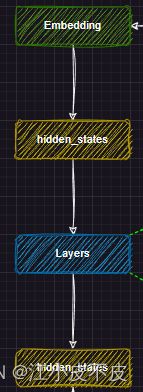Llama 架构分析
从代码角度进行Llama 架构分析
- Llama 架构分析
-
- 前言
- Llama 架构分析
-
- 分词
- 网络主干
-
- DecoderLayer
-
- Attention
- MLP
- 下游任务
-
- 因果推理
- 文本分类
Llama 架构分析
前言
Meta 开发并公开发布了 Llama系列大型语言模型 (LLM),这是一组经过预训练和微调的生成文本模型,参数规模从 70 亿到 700 亿不等。
在大多数任务中,LLaMA-13B要比GPT-3(175B)的性能要好,LLaMA-65B和组好的模型Chinchilla-70B以及PaLM-540B的实力相当。
Llama 架构分析
分词
分词部分主要做的是利用文本分词器对文本进行分词
tokenizer = AutoTokenizer.from_pretrained(PATH_TO_CONVERTED_TOKENIZER)
text = "Hey, are you conscious? Can you talk to me?"
inputs = tokenizer(text, return_tensors="pt")
网络主干
主干网络部分主要是将分词得到的input_ids输入到embedding层中进行文本向量化,得到hidden_states(中间结果),然后输入到layers层中,得到hidden_states(中间结果),用于下游任务。
self.embed_tokens = nn.Embedding(config.vocab_size, config.hidden_size, self.padding_idx)
self.layers = nn.ModuleList(
[MixtralDecoderLayer(config, layer_idx) for layer_idx in range(config.num_hidden_layers)]
)
self._use_flash_attention_2 = config._attn_implementation == "flash_attention_2"
self.norm = MixtralRMSNorm(config.hidden_size, eps=config.rms_norm_eps)
DecoderLayer
主干网络的layers层就是由多个DecoderLayer组成的,由num_hidden_layers参数决定,一般我们说的模型量级就取决于这个数量,7b的模型DecoderLayer层的数量是32。
DecoderLayer层中又包含了Attention层和MLP层,主要的一个思想是利用了残差结构。
如下图所示,分为两个部分
第一部分
- 首先,将hidden_states(文本向量化的结构)进行复制,即残差
- 归一化
- 注意力层
- 残差相加
第二部分
- 首先将第一部分得到的hidden_states进行复制,即残差
- 归一化
- MLP层
- 残差相加
外链图片转存失败,源站可能有防盗链机制,建议将图片保存下来直接上传
#复制一份
residual = hidden_states
#归一化
hidden_states = self.input_layernorm(hidden_states)
#注意力层
hidden_states, self_attn_weights, present_key_value = self.self_attn(
hidden_states=hidden_states,
attention_mask=attention_mask,
position_ids=position_ids,
past_key_value=past_key_value,
output_attentions=output_attentions,
use_cache=use_cache,
padding_mask=padding_mask,
)
#加上残差
hidden_states = residual + hidden_states
#复制一份
residual = hidden_states
#归一化
hidden_states = self.post_attention_layernorm(hidden_states)
#mlp
hidden_states = self.mlp(hidden_states)
#加上残差
hidden_states = residual + hidden_states
outputs = (hidden_states,)
if output_attentions:
outputs += (self_attn_weights,)
if use_cache:
outputs += (present_key_value,)
return outputs
Attention
进行位置编码,让模型更好的捕捉上下文信息
#经过线性层
query_states = self.q_proj(hidden_states)
key_states = self.k_proj(hidden_states)
value_states = self.v_proj(hidden_states)
#多头注意力形状变换
query_states = query_states.view(bsz, q_len, self.num_heads, self.head_dim).transpose(1, 2)
key_states = key_states.view(bsz, q_len, self.num_key_value_heads, self.head_dim).transpose(1, 2)
value_states = value_states.view(bsz, q_len, self.num_key_value_heads, self.head_dim).transpose(1, 2)
kv_seq_len = key_states.shape[-2]
#计算cos、sin
#计算旋转位置嵌入
cos, sin = self.rotary_emb(value_states, seq_len=kv_seq_len)
query_states, key_states = apply_rotary_pos_emb(query_states, key_states, cos, sin, position_ids)
#计算权重
key_states = repeat_kv(key_states, self.num_key_value_groups)
value_states = repeat_kv(value_states, self.num_key_value_groups)
attn_weights = torch.matmul(query_states, key_states.transpose(2, 3)) / math.sqrt(self.head_dim)
#加上掩码
attn_weights = attn_weights + attention_mask
#计算softmax
attn_weights = nn.functional.softmax(attn_weights, dim=-1, dtype=torch.float32).to(query_states.dtype)
attn_output = torch.matmul(attn_weights, value_states)
attn_output = self.o_proj(attn_output)
MLP
mlp层的主要作用是应用非线性激活函数和线性投影。
- 首先将attention层得到的结果经过两个线性层得到gate_proj和up_proj
- gate_proj经过激活函数,再和up_proj相乘
- 最后经过一个线性层得到最后的结果
self.gate_proj = nn.Linear(self.hidden_size, self.intermediate_size, bias=False)
self.up_proj = nn.Linear(self.hidden_size, self.intermediate_size, bias=False)
self.down_proj = nn.Linear(self.intermediate_size, self.hidden_size, bias=False)
self.act_fn = ACT2FN[config.hidden_act]
down_proj = self.down_proj(self.act_fn(self.gate_proj(x)) * self.up_proj(x))
下游任务
因果推理
所谓因果推理,就是回归任务。
self.lm_head = nn.Linear(config.hidden_size, config.vocab_size, bias=False)
文本分类
即分类任务
self.score = nn.Linear(config.hidden_size, self.num_labels, bias=False)





